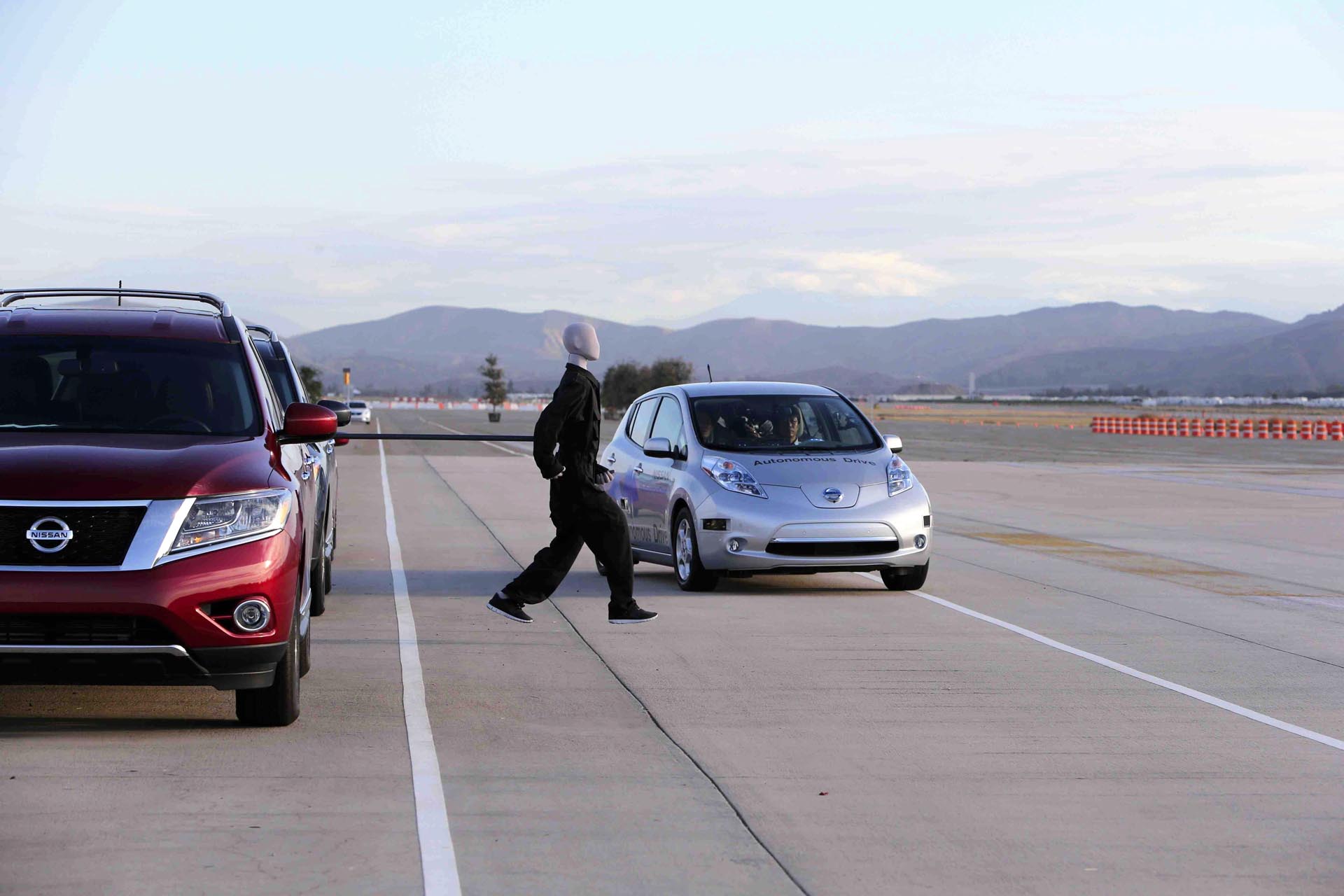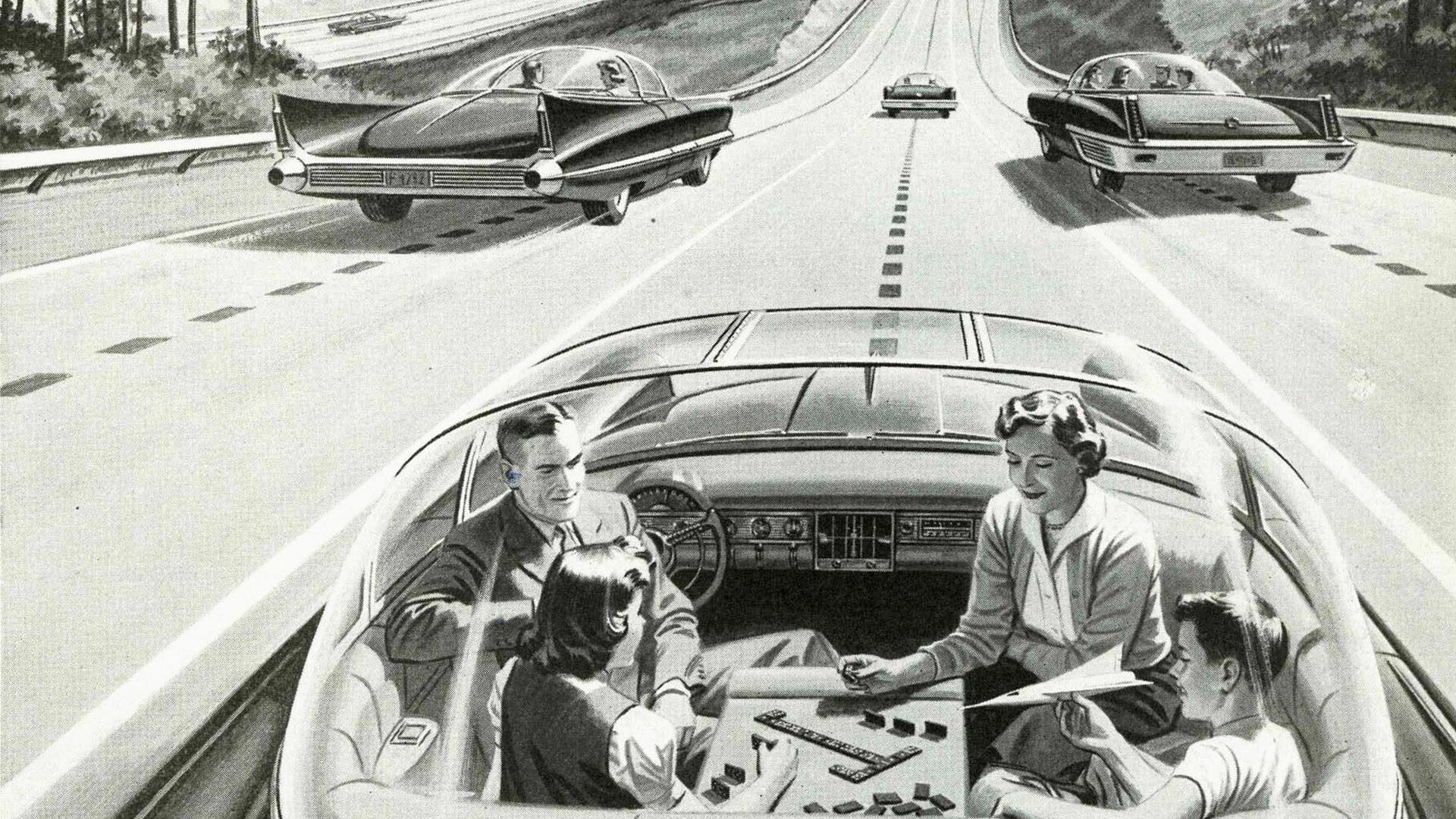At the dawn of the automotive age, professional chauffeurs were the first drivers required to obtain a driving licence. Private motorists resisted, arguing that licenses were “meddlesome” and unnecessarily restrictive.
But arguments against licensing soon ceased when governments realized they could generate huge revenues by requiring every motorist to not only have one, but to renew it annually.
Interested in all things automotive, I purchased a vintage Ontario driving licence at an antique store a couple of years ago; number 12561, issued in 1920. At first, I didn’t know what it was. No, it’s not a piece of paper that you carry in a wallet or purse; it’s a metal disk that its owner would wear pinned to a hat or lapel. That’s how they made them, somewhat underestimating the number of licenses that would be required.
Naturally, driving tests were also in their infancy. Apparently Manitoba’s Ace Emmett (known across Canada in the early 1900s as “Mr. Highways”) passed his test by demonstrating that he could avoid running over a dummy thrown in front of his car by testers hiding behind some bushes at the side of the road.
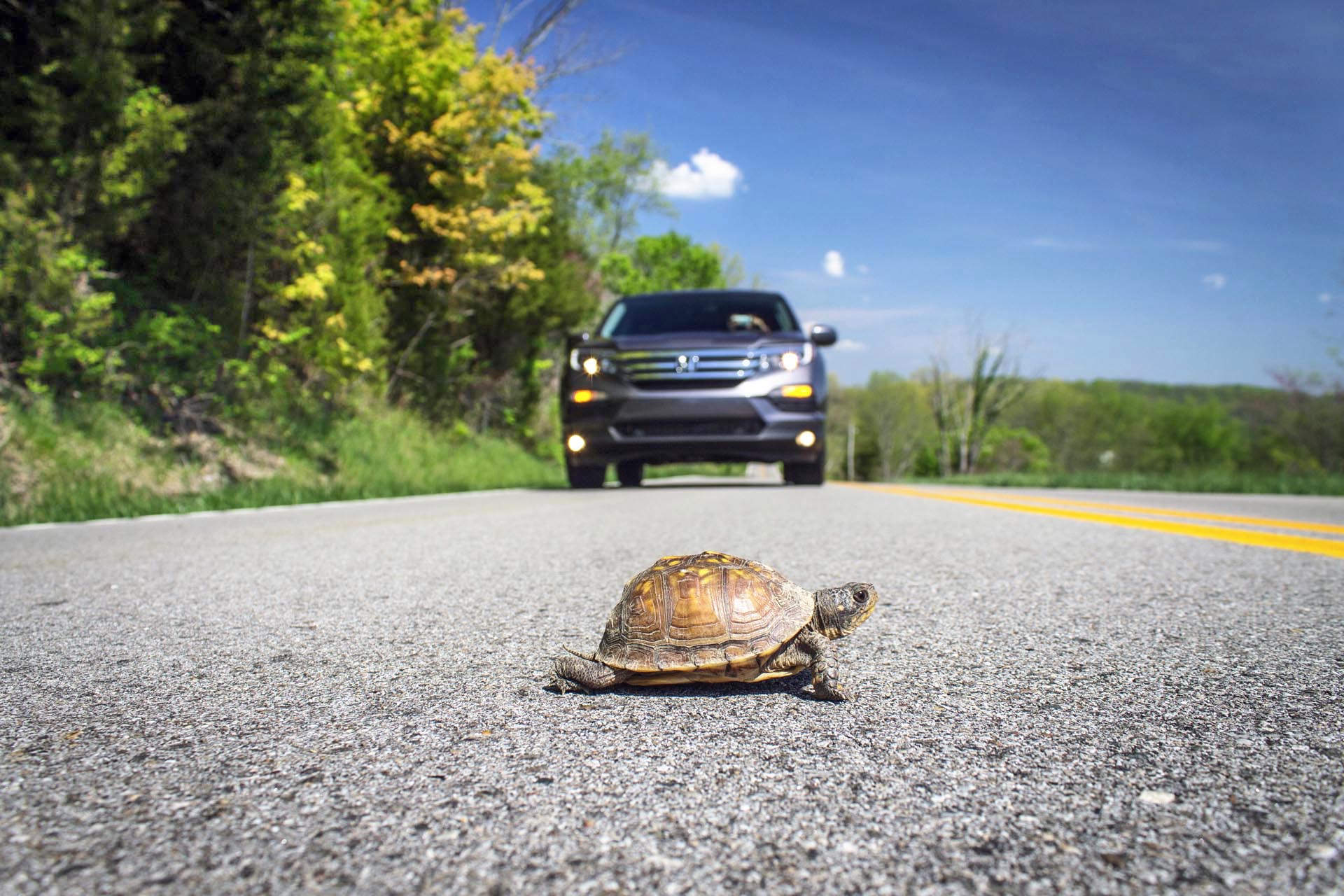
Fast forward 100 years, and now we’re talking about licensing not only the driver, but the car as well. After all, in a self-driving car – the proliferation of which is an inevitability – who is the passenger and who is the driver? This is the kind of question that governments, insurers and law enforcement agencies are grappling with, but they’d better come up with some answers soon, before self-driving cars simply blow right by them.
In a recent paper from the University of Michigan Transportation Research Institute, authors Michael Sivak and Brandon Schoettle tackled the licensing issue by asking, “Should we require licensing tests and graduated licensing for self-driving vehicles?
In other words, should self-driving vehicle models be tested to determine their ability to manage all situations that may be encountered in real-world driving? And then be issued a license just like a person. Furthermore, should people get special licenses to operate self-driving cars?
First of all – and before everyone resoundingly says, “Of course!” or “Are you crazy?” – don’t forget that when it comes to getting a driving licence, current practice is that people aren’t tested for much beyond a limited understanding of rules of the road and driving competence in normal conditions. So it’s not like a well-engineered self-driving car will necessarily be less safe than an inexperienced or poor driver, licensed or not.
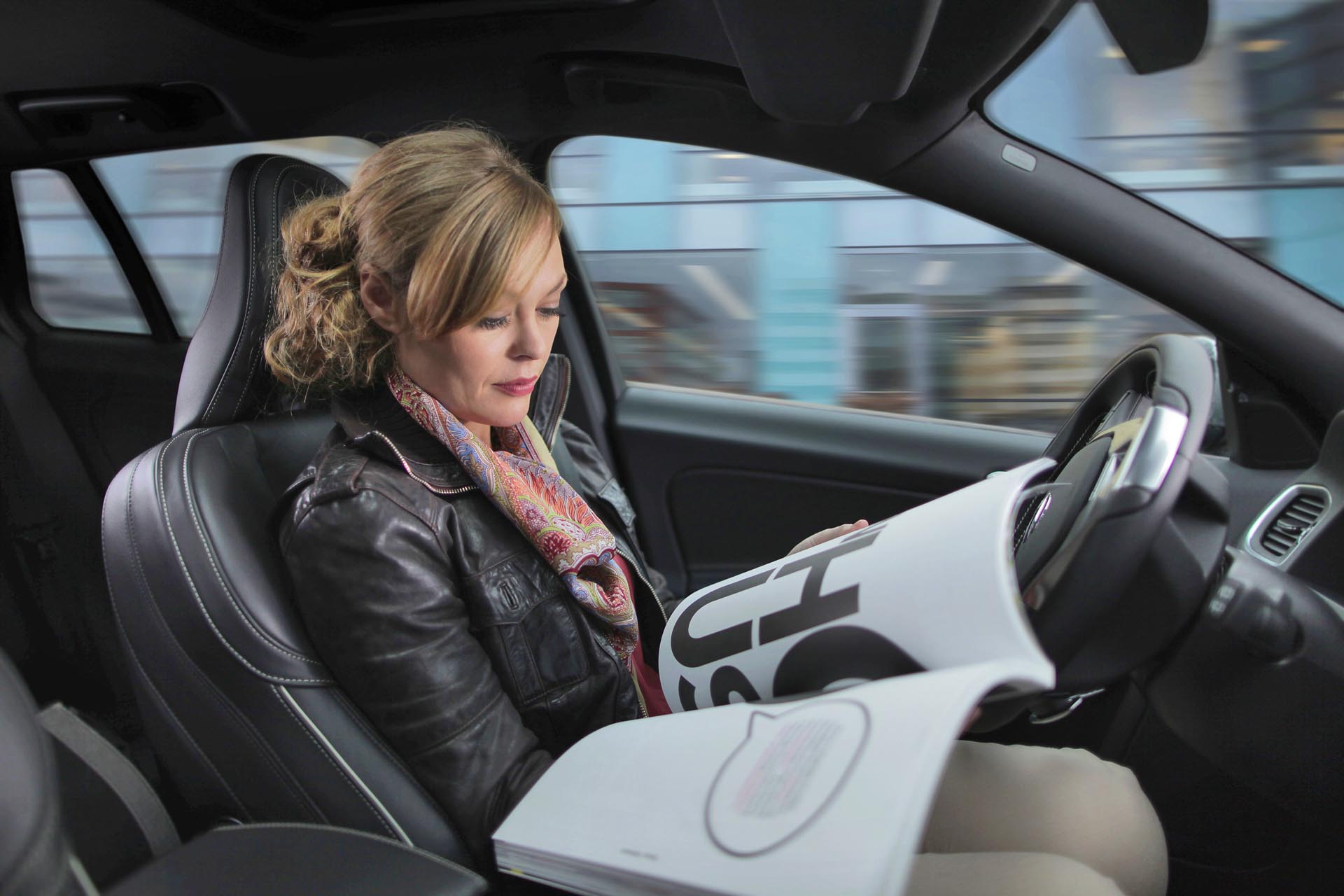
In Ontario’s graduated licensing system, for instance, you receive your first licence by being at least 16 years old, having good eyesight and some knowledge of the driving regulations. And a pulse, as they say. There is no driving test required to acquire this G1 licence.
After a year of driving accompanied by a fully licensed passenger (although never between the hours of midnight and 5.00 am or on a multi-lane highway), the neophyte G1 driver takes the first driving test, which includes turning right, turning left, stopping and parking. Get this right and you receive a G2 license which permits you to drive anywhere at any time although there are conditions if you are under 19 years of age.
Subsequently, the G2 driver takes a test that includes driving on a highway and parallel parking. Pass this and you have a full “G” license. Consider yourself tested and ready to drive anywhere in Canada!
Note that none of the driving tests include driving at night, and nor do they at any time simulate emergency manoeuvers or vehicle control on slippery surfaces. Nor even do they anticipate the need for differing skill levels between driving a Nissan Micra, for instance, and a Nissan GT-R. Finally (and ludicrously, in my view) formal driver education is not a requirement to receive a driving license in Ontario.
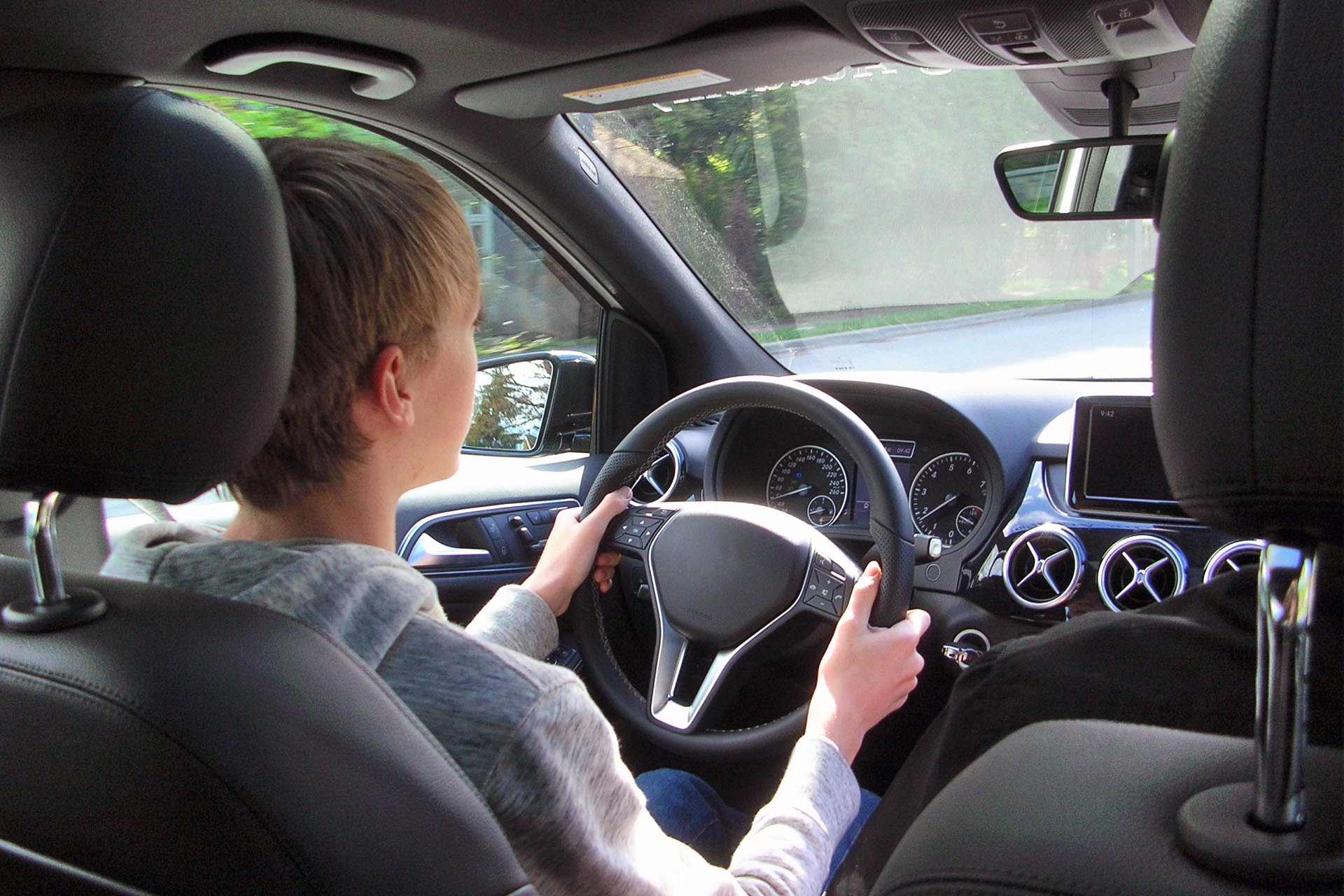
To be fair, signing up for driver education is an incentive as enrolling in a program speeds up the licensing process. But in my experience, many driver training programs simply anticipate the requirements of the test and don’t extend to additional driving skills. Heck, Young Drivers of Canada, for instance, no longer even offers a manual shifting option.
But I digress. Messrs Sivak and Schoettle suggest the same basic licensing requirements for self-driving cars as for people:
1. They’ll need to demonstrate visual performance
2. They’ll need knowledge of driving and traffic laws and regulations and
3. They’ll need to demonstrate a sufficient level of driving skills.
The problem is the unproven efficacy of the technology involved, hence the flurry of industry testing on public roads and closed circuits currently taking place worldwide. Let’s face it; the move from driving a car to being driven by a car is nothing short of a transportation revolution.
One problem is that visual performance technologies currently available and under development for vehicles are better at some tasks than others. Anyone who has a camera-based blind spot information system knows that when it rains, the system will often shut down. Likewise radar-based collision mitigation systems and “intelligent” cruise control systems are challenged by snow, dust and cornering.
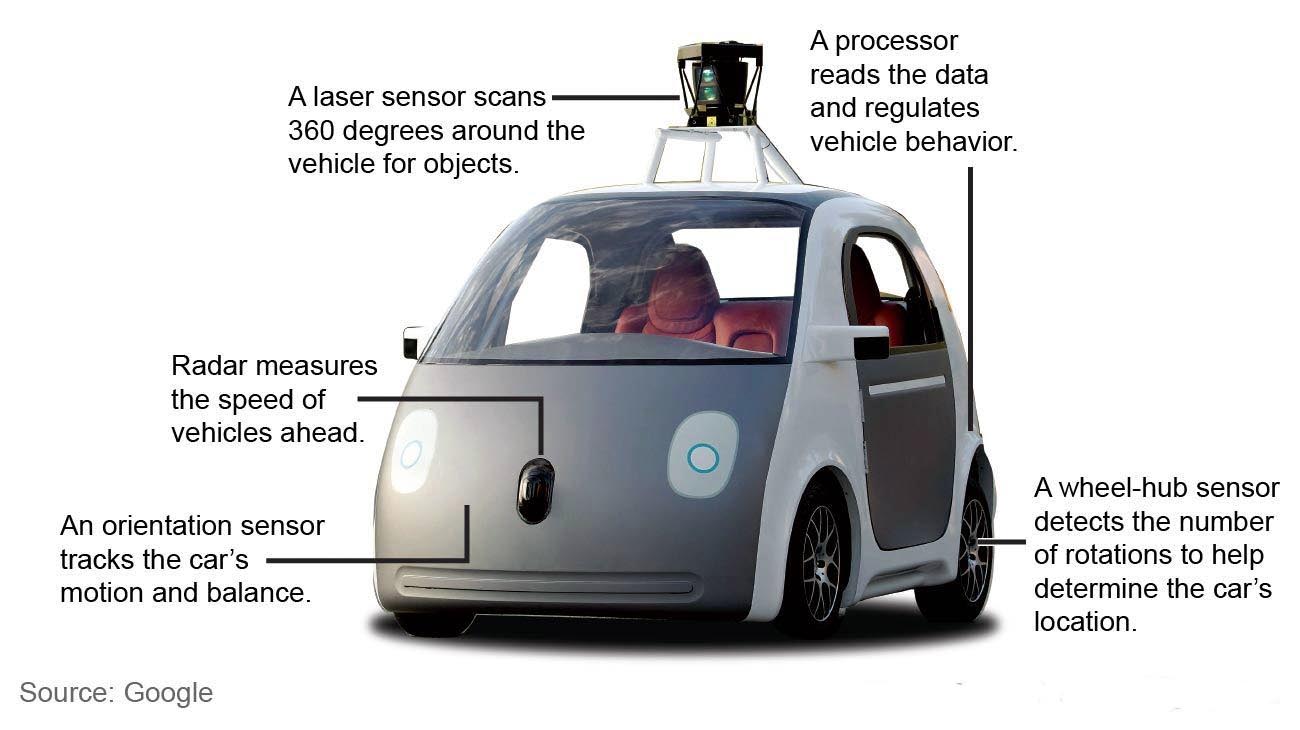
The authors of the University of Michigan paper also identify the pattern recognition challenges faced by the software that manages a self-driving car. Reflections on a wet road, for instance, are difficult for computers to resolve, and downed power lines are a problem to recognize. Basically, situations like these confuse computers. The human brain, in contrast, is good at interpreting such unusual visual phenomena.
Sivak and Schoettle do allow that downloading all driving and traffic laws and regulations would be “relatively easy.” The vehicle would know where it is using GPS, and drive according to regulations in each jurisdiction.
Then again, people are “relatively lax” about many laws and regulations (in an 80 km/h zone, many drivers choose to drive at 90, for instance, or they’ll push through an amber light barely clearing an intersection). Maybe the “driver” can tailor the self-driving car to behave according to certain personal preferences regardless of the regulations? You can bet that some will try.
Driving skills are something else. Some self-driving prototypes, “occasionally cross the centerline on curves even in good weather conditions, and do so not by design.” And “on rare occasions, self-driving vehicles will face ethical dilemmas of having to choose the lesser of two evils.” Maybe it won’t be that rare…
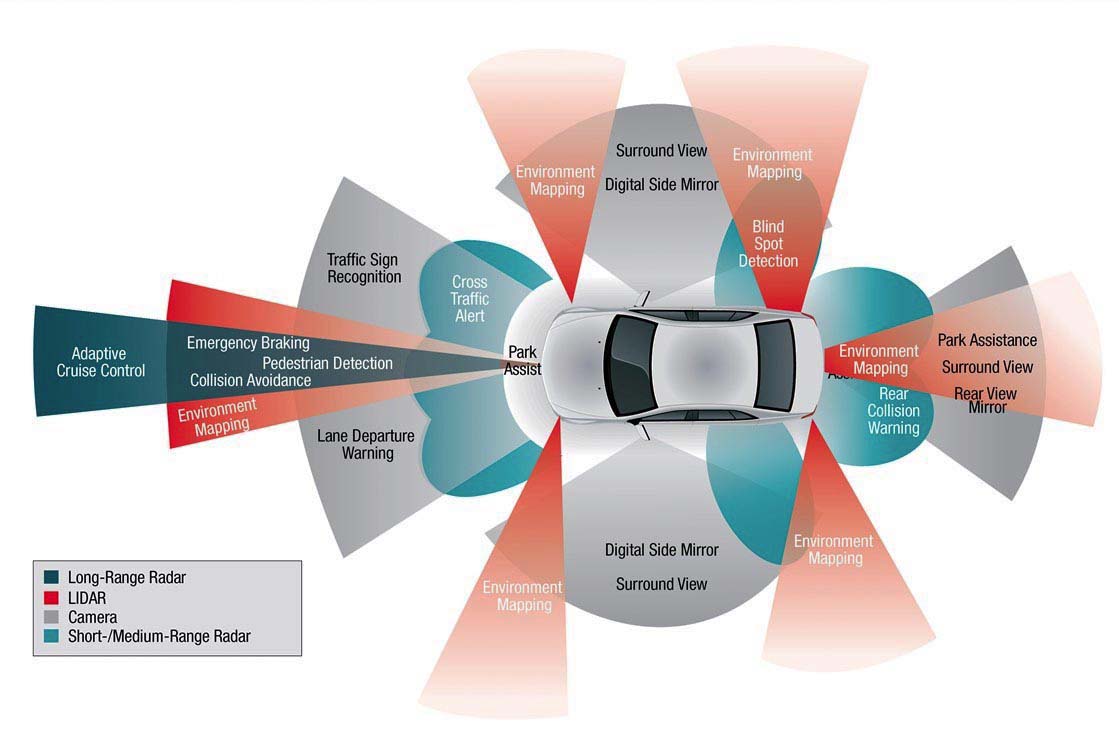
All to say, the authors of the University of Michigan paper conclude that a self-driving vehicle “either has the software and hardware to deal with a particular situation, or it does not.” Consequently, a graduated licensing approach would make sense if a particular car manufacturer decides to limit their vehicles’ self-driving operation to certain conditions. What this requires is that the self-driving capabilities of a vehicle could be disengaged in order that the owner (responsible occupant?) can “take over” on occasion.
“We’re going manual!” in other words. Assuming that the person taking over knows how to drive, that is. And that the vehicle has a steering wheel and all the pedals, knobs and levers that humans require to actually drive a car.
Yes, it’s a can of worms. The Institute of Electrical and Electronics Engineers (IEEE) is in the thick of it, asking whether, therefore, individuals will need a new type of license to operate a self-driving car. What they want to know is “How do you train a driver not to drive?” That is, when the car’s “in charge,” so to speak… And will you need extra training or a specially designated license that would permit you to “take over,” when the need arises.
Because there will come a time when the occupant has to assume control if the self-driving car malfunctions or if it enters an area of dense fog where the car has no clue what to do. Maybe it just stops. You’d better not be napping!
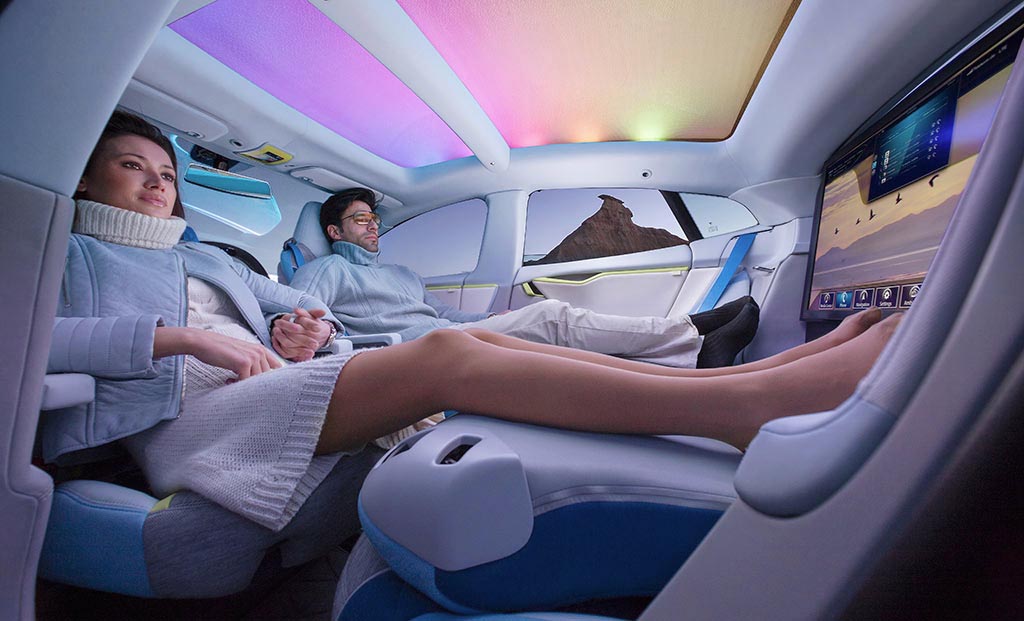
As the IEEE’s Mark Harris puts it, “Self-driving cars promise a future where you can watch television, sip cocktails, or snooze all the way home. But what happens when something goes wrong? Today’s drivers have not been taught how to cope with runaway acceleration, unexpected braking, or a car that wants to steer into a wall.”
Indeed. So it’s possible that not only would production self-driving cars be “licensed” to operate in certain conditions, but that your personal license could be specially graded to permit you to assume control if and when required. Such upgrading could require classroom sessions, computer simulations and on-road driving in a self-driving vehicle. Probably a fee would be required. Okay, not probably… .
Somehow, though, I don’t think the driving public will be interested in paying for a car license in addition to a driving license, nor will they be happy about having to upgrade their personal license in order to take the wheel (or not take the wheel) of a self-driving car. After all, drivers are already in charge of vehicles whose safety technologies – antilock brakes (ABS), stability control systems, and active steering controls – are completely mysterious to them. And as alluded to above, most no longer even know how to shift gears.
Governments didn’t require special upgrading when ABS was introduced (and I’m convinced that many if not most drivers still “pump the brakes” in emergency stopping situations, immediately defeating the purpose of the ABS system. And did you know you can steer the vehicle while the ABS is active? Maybe you did, but I’ll bet many do not.
More likely, driver training (hopefully) will evolve and automation technology will standardize. At the very least, manufacturers could surely take a more hands-on role in preparing buyers of semi-automated and automated vehicles when they are purchased.
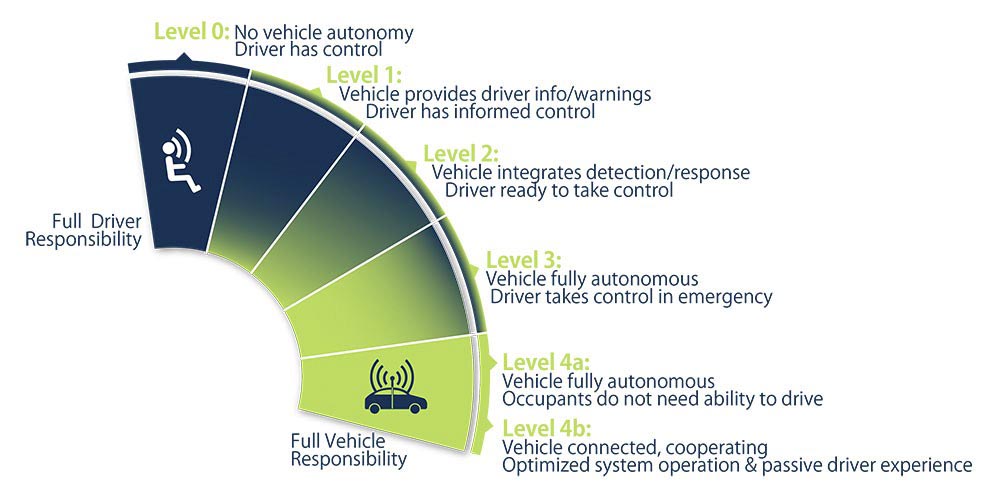 US National Highway Traffic Safety Authority (NHTSA) Levels of Vehicle Autonomy.
US National Highway Traffic Safety Authority (NHTSA) Levels of Vehicle Autonomy.
That said, while some jurisdictions are moving along swiftly when it comes to licensing or at least studying and permitting the testing of self-driving cars, Ontario has not been a leader in this area. So it’s encouraging to see the province waking up to the new automotive realities with its latest amendment to the Highway Traffic Act: Ontario Regulation 306/15 – Pilot Project – Automated Vehicles. It comes into force on January 1, 2016.
Basically, regulation 306/15 allows for the testing of automated vehicles on public roads. At this point, such vehicles won’t be “licensed” but they will be “approved.” Don’t worry; you won’t see some driverless car charging along beside you like a headless horseman. But you may see a person in a car with no hands on the steering wheel, monitoring the vehicle and surrounding environment.
To be clear – and this is relevant regarding the licensing and operation of self-driving vehicles – according to regulation 306/15, “A person seated in the driver’s seat of an automated vehicle is considered to be driving the automated vehicle, and to be the driver of the vehicle, with or without the automated driving system being engaged.”
No question about responsibility, in case you were wondering. It’s the human.
Furthermore, the owner of the vehicle must be an approved manufacturer or a technology company, an academic or research institution or company that manufactures parts, systems, equipment or components for automated driving. And the vehicle can only be on the road for testing purposes.
This pilot project ends in 2026, which also is interesting given that Toyota recently announced it will have fully self-driving cars on the road by 2020. Toyota now uses the term, “automated driving,” which is certainly consistent with Ontario’s “Automated Vehicle” pilot project, although the race to get self-driving or partially self-driving cars on the road is becoming a frenzy and the hugely competitive auto sector seems far ahead of legislators.
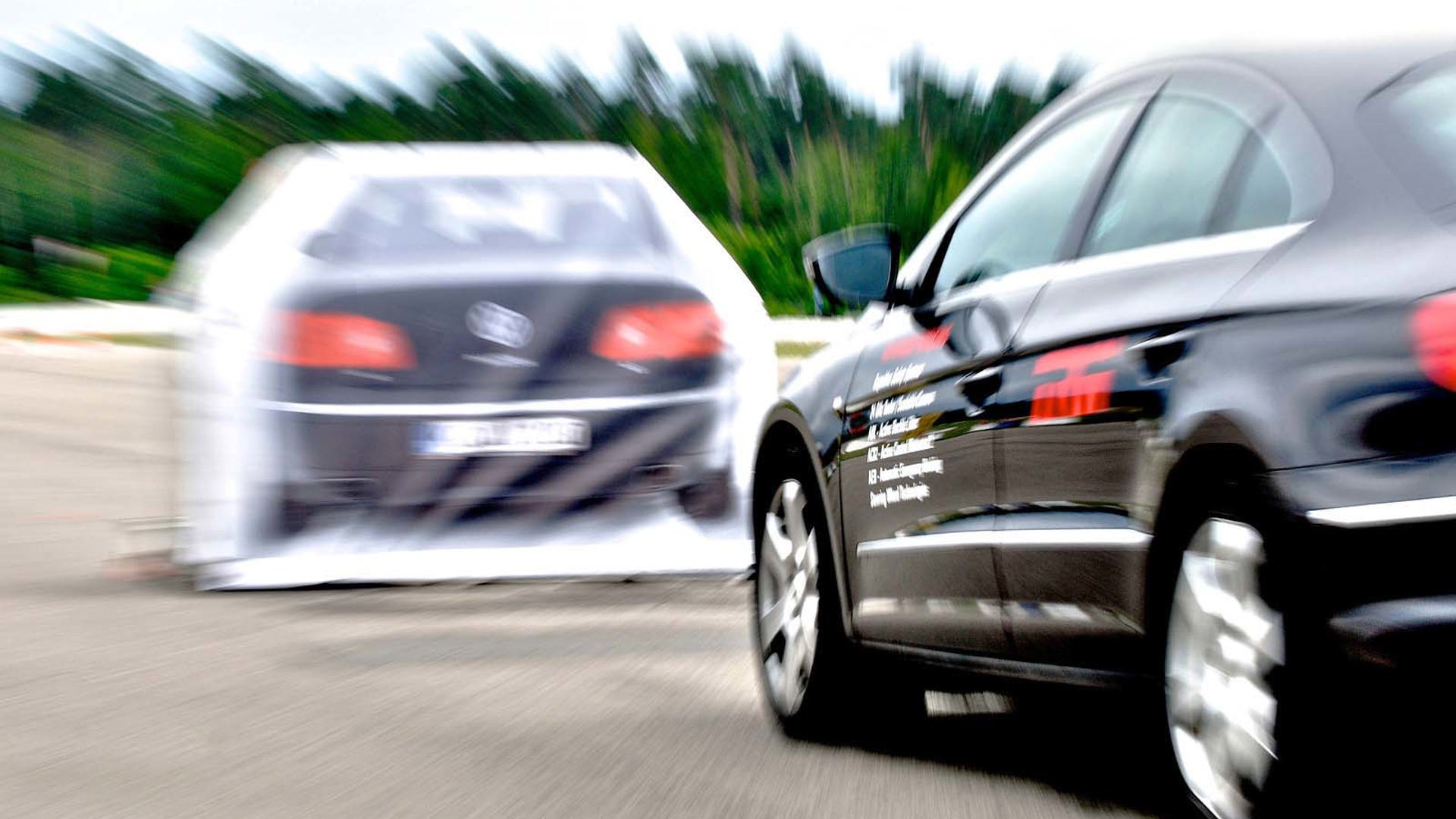
“Legacy” manufacturers like Toyota, Volkswagen, Ford and General Motors are busy rolling out new “assistive” technologies right and left – cars that park themselves, cars that brake autonomously, cars that stay in their lane, cars that wake you up – are all available now. In contrast “Silicon Valley” in the form of Google and Apple, is moving slowly but looming large as it rattles the auto sector with the threat of trendy and appealing little vehicles plugged into the grid and into the sharing economy. Somewhat straddling the two sectors, you have a company like Tesla, whose development we watch with fascination.
Licensed or not, automated vehicles are coming to showrooms faster than you may think, and apparently sooner than governments expected. It’s the new boom market for personal and maybe mass transportation. Cadillac’s Super Cruise semi-autonomous system, for instance, permits equipped vehicles to self-drive on the highway and steer itself through busy intersections. It’s announced for model year 2017, which based on past practice we’ll see on the road in less than 12 months.
No-one’s talking about licensing such cars (at least, GM’s certainly not), or specially designating them as partially self-driving. And I haven’t heard of anyone proposing special training for owners of such vehicles. Super Cruise is just going to be available, presumably for anybody to buy with a conventional driving license and the required down-payment.
It’s not exactly the Wild West, but it is a scramble out there. An orderly, planned, methodical and controlled transition to self-driving vehicles is just not happening.
You’ll know the outcome when it arrives: that is the long and the short of it. I expect your license will be good as long as you continue to renew it and avoid hitting things.
Ace Emmett would certainly be amazed. Especially if he knew that when I was riding in a self-driving Autonomous Nissan Leaf, a machine effectively threw a dummy in front of it to demonstrate how the Leaf could avoid running it over.
Like Mr. Emmett, the Leaf passed the test.
